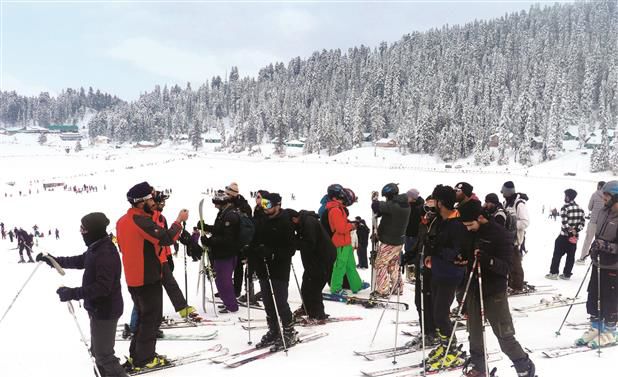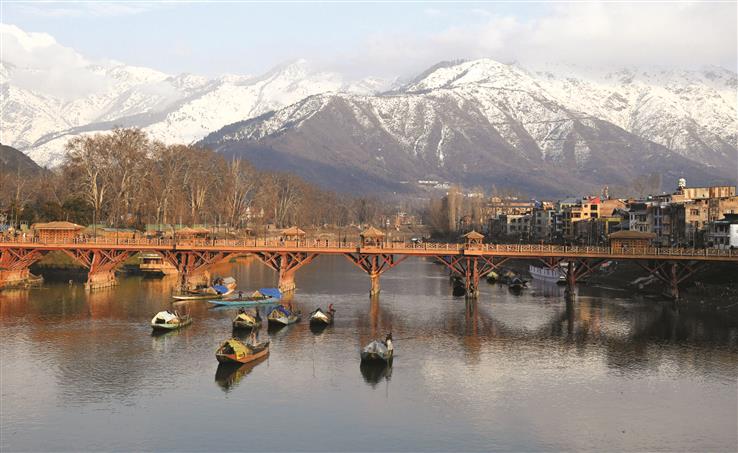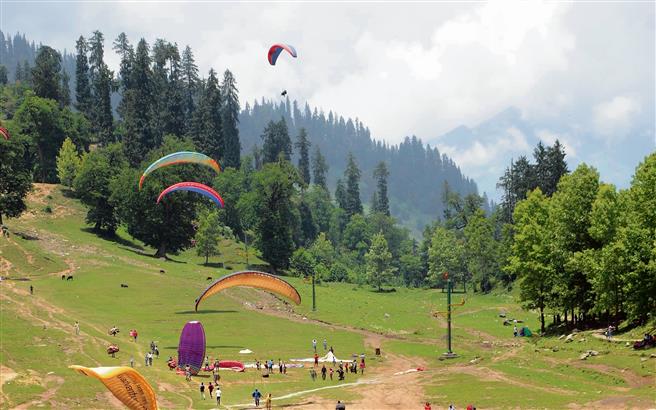
The talking point in December and early January was the absence of snow and the rise in temperature in Kashmir, though there was no dip in tourist arrivals. When it finally snowed, the popular ski resort of Gulmarg was chock-a-block with enthusiasts. ANI
Naseer A Ganai
On January 15 this year, at the picturesque but unusually dry and snowless Gulmarg, Billa Majeed Bakshi modified his heliskiing venture. In the absence of skiers — mostly foreign — owing to the arid weather conditions, Bakshi found a silver lining in catering to domestic thrill-seekers, offering them joy rides to the snow-clad peaks. With his fleet of two helicopters, Bakshi ferried over a hundred tourists every day to the breathtaking Sunshine Peak, standing tall at 14,000 feet. Each tourist was charged Rs 13,000 for the unique experience. In the dry season, while many lamented about climate change and its impact on tourism, Bakshi remained hopeful of snow, convinced that Kashmir’s tourism is immune to weather changes.

Echoing his sentiments, hoteliers in Gulmarg acknowledge the surge in tourist footfall, regardless of the weather conditions. By February 22, as Gulmarg was under heavy snow, Bakshi’s helicopters witnessed long queues, accommodating both foreign and domestic tourists for heliskiing and joy rides. “Domestic tourists coming to Kashmir are affluent and have spending power more than that of foreigners,” says Bakshi. Room rents of Rs 40,000 are not unusual.
Stakeholders agree that the tourism sector in Kashmir has attuned itself to being an all-weather destination, factoring in the disappointment of not witnessing snow or being snow-bound by offering various options to engage tourists.
A senior official at the Gulmarg Development Authority says that Gulmarg receives around 5,000 to 7,000 tourists daily and the primary concern here is “over-tourism”. Whatever the weather conditions, he adds, the influx of tourists persists in the Valley. “Gulmarg is also a larger reflection of Kashmir. Whosoever visits Kashmir visits Gulmarg.”
The tourist rush, however, is by no means a validation that climate change is not impacting lives and livelihoods. With an average glacier thinning of 0.35 metre per year in Jammu and Kashmir and Ladakh Himalayas, experts lay stress on the urgency to understand the impact of climate change on water resources.
Prof Shakeel Romshoo, Vice-Chancellor of Islamic University of Science and Technology, says the indicators of climate change are very clear. “We have observed an increased frequency of dry spells during the last few decades,” he adds.
A study titled ‘Time Series Analysis of Climate Variability and Trends in Kashmir Himalaya’ reveals that between 1980 and 2020, the average annual mean maximum temperature in Kashmir increased by 2 degrees. It marks a substantial increase of 0.5 degree Celsius per decade — far surpassing the global average rise of 0.2.
The study warns of the potentially grave environmental consequences of shifting precipitation patterns, which could profoundly impact food security and ecological sustainability in the region if these trends persist unchecked.
On January 9, temperatures reached 14.2 degree Celsius in Srinagar, 8 degrees above the average for that time of year and more than Delhi’s temperature.
Amid concerns over weather patterns, the push to develop tourist spots and promote the sector is all too visible in Srinagar. It is best reflected in the way the wooden Zero Bridge on the Jhelum river bundh has evolved into a hangout for youth, artists, students and even aspiring politicians.
Situated around 2 km from Lal Chowk, the heart of the city, this bridge began to collapse in 2012. A public outcry led to the state government initiating its reconstruction. By 2016, the then Chief Minister Mehbooba Mufti inaugurated the bridge for pedestrians, promoting it as a heritage tourism destination. In the past few years, the administration has poured in huge investments. Crafted from the resilient wood of deodar and walnut trees, indigenous to Kashmir, this bridge stands as a spectacular marvel.
The vehicular ban has transformed it into a trendy spot. The administration regularly organises events here, like the Kashmir Spring Festival and winter fest. Last year, an all-women art workshop was organised here by Opus Kala Sanyojan. Around 60 artists from different states participated.
According to tourism officials, nearly 21 lakh tourists visited the Valley last year. The administration claims a whopping 2.11 crore people visited J&K. The huge difference, the non-BJP parties claim, is because even pilgrims visiting Mata Vaishno Devi and Amarnath shrines are being shown as tourists. Notwithstanding the dispute over the numbers, there is no denying a surge in tourist arrivals. It marks a significant recovery for Kashmir’s hospitality sector, which was severely impacted first due to curfew-like restrictions following the abrogation of Article 370 on August 5, 2019, and later in 2020 due to curbs imposed during Covid-19.
Old-timers recall that tourism experienced a gradual upswing when the Farooq Abdullah government initiated an infrastructure upgrade in the late 1990s, including the construction of the Royal Springs Golf Course. During Mufti Mohammad Sayeed’s tenure in 2002, further efforts were made to improve the tourism scene. The government also disassociated tourism from the discourse of normalcy, saying it was not a barometer for peace and calm. By 2012, during Omar Abdullah’s administration, Kashmir witnessed a surge in tourist arrivals, exceeding over 10 lakh visitors. Slowly, downtown Srinagar also became a tourist attraction, with its old houses, shopping malls, shrines and food outlets.
Over the years, successive Chief Ministers and Governors toured Srinagar and even addressed people. Omar Abdullah went to the old city in 2009 and later in 2010. In 2018, the then Governor NN Vohra undertook an extensive tour of downtown Srinagar. In 2022, Lt Governor Manoj Sinha visited the interiors of the city.
The biggest blow to tourism came before the abrogation of Article 370. A series of orders created panic across the erstwhile state. On August 2, 2019, all tourists and pilgrims were asked to leave the Valley as soon as possible. Soon, the UK, Australia, the US, Germany and Canada put Kashmir on their travel advisories. These have not been modified so far. In 2020, after the government lifted restrictions on travel, 41,267 tourists, including 3,897 foreigners, visited Kashmir — the lowest number since 1990.
In his Republic Day speech this year, Lt Governor Sinha said tourism is a way of life for J&K and reflects spiritual experiences that contribute massively to the local economy. “This paradise on earth witnessed a record influx of 2.11 crore tourists during 2023, and the G20 Summit held in Srinagar in May led to a 2.5 times increase in the arrival of foreign tourists. There has been a significant influx of tourists in offbeat destinations. Nearly 20 lakh visited Shiv Khori, 10.05 lakh Mansar-Surinsar, 10 lakh each visited Patnitop and Dudhpathri, and 15,000 went to Lolab,” he said.
The tourism sector has been accorded industry status, granting access to electricity tariff and levies at industrial rates. The government is also actively promoting a homestay policy to boost tourism in remote areas and improve the local economy.
Places like Gurez, nestled near the Line of Control in northern Kashmir, have emerged as the new tourist destinations, experiencing a 300 per cent increase in visitor numbers over the past two years. In 2023 alone, nearly 50,000 tourists visited this scenic locale. Efforts are underway to connect Gurez with Kargil via Kabuli Gali.
Once known for cross-LoC shelling, tourists were reluctant to visit the border areas. The tide turned after the India-Pakistan border truce in 2003 and its reaffirmation in 2021. During summer months, there is now a steady stream of tourists and trekkers. In Uri town, 100 km north of Srinagar, despite the cold weather, shopkeepers open shops early in the morning. There is no fear of shells landing in the market or heavy firing in nearby mountains. Cricket legend Sachin Tendulkar was the latest celebrity to visit the area.
While the authorities are providing a massive infrastructural push in J&K and Ladakh, particularly focusing on road construction, there is growing concern about recurrent landslides. In Ladakh, activists are openly expressing apprehensions and advocating environmental safeguards. Last year, a Joshimath-like crisis hit Doda district where several families were evacuated after their homes developed cracks.
“We rely heavily on leisure, adventure and corporate tourism. I don’t believe changing weather patterns or depleting water resources significantly impact tourism though occasionally, disruptions do occur,” says Nasir Shah, chairman of the Indian Association of Tour Operators, J&K chapter. The opportunities provided by a flourishing tourism sector are hard to resist, but experts sound a note of caution.
Advocate Nadeem Qadri, an environmental activist, calls for a more serious environmental and sustainable approach related to expansion of tourism infrastructure as most destinations are ecologically-sensitive areas. “All possible precautions must be taken to avoid any tampering with nature. Streamline the infrastructural needs by way of a strict tourism policy based on sustainable development principles,” he says.
Experts say the tourism stakeholders in Jammu and Kashmir would do well to not take the suggestions lightly. Tourism-dependent Himachal Pradesh and Uttarakhand, they point out, offer prime examples of the havoc that reckless construction activity and environmental damage, in the absence of regulatory checks, can cause.
Called the ‘Meadow of Flowers’, Gulmarg is around 60 km from Srinagar — a scenic drive of an hour-and-a-half. The top attraction is the Gulmarg Gondola, the highest cable car in the world. The first part of the Gondola goes up to 8,530 feet, and the second part reaches a remarkable 12,293 feet. In winter, Gulmarg becomes a haven for skiers, with its snowy terrain providing challenging slopes. This winter, though, delayed snowfall upset plans.

In HP, ‘winter has been a tough one’
Himachal Pradesh has been experiencing a widening impact of changing weather patterns. After the devastation during the monsoon last year, the tourism industry of Kullu-Manali got hit by the delay in snowfall. In November, room occupancy in Manali’s hotels was below 30 per cent. By mid-December, it had gone up a notch, touching almost 80 per cent during Christmas and New Year eve. January proved to be disappointing for the tourism sector because of scant snowfall, though the tourist arrival numbers in February were much better.
Anup Thakur, president of the Kullu-Manali Paryatan Vikas Mandal, says that “snow has a direct connection with the tourism industry of Kullu-Manali. This winter has been tough”. What’s largely missing in the discourse is the need to draw lessons and mandatorily impose norms that promote sustainability.
Dr JC Kuniyal, head, Centre for Environmental Assessment and Climate Change, GB Pant National Institute of Himalayan Environment, Almora, reminds how global warming — whether due to deforestation, damage to nature for development, or emission of carbon gases — is a major cause of changing climatic conditions. Refusing to pay heed is self-defeating. — Dipender Manta

Join Whatsapp Channel of The Tribune for latest updates.



























